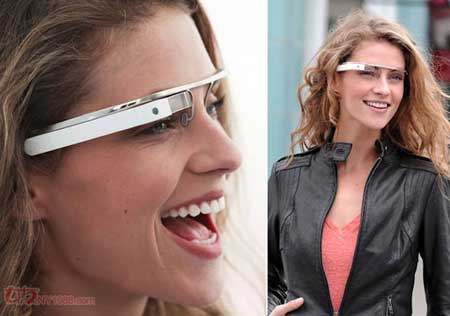 |
|
These glasses can do anything you now need a smartphone or tablet computer to do —and then some. |
|
If you think texting while walking is dangerous, just wait until everyone starts wearing Google's futuristic, Internet-connected glasses. While wearing a pair, you can see directions to your destination appear literally before your eyes. You can talk to friends over video chat, take a photo or even buy a few things online as you walk around. These glasses can do anything you now need a smartphone or tablet computer to do —and then some. Google gave a glimpse of "Project Glass" in a video and blog post this week. Still in an early prototype stage, the glasses open up endless possibilities — as well as challenges to safety, privacy and fashion sensibility. The prototypes Google displayed have a sleek wrap-around look and appear nothing like clunky 3-D glasses. In development for a couple of years, the project is the brainchild of Google X, the online search-leader's secret facility that spawned the self-driving car and could one day send elevators into space. If it takes off, it could bring reality another step closer to science fiction, where the line between human and machine blurs. "My son is 4 years old and this is going to be his generation's reality," said Guy Bailey, who works as a social media supervisor for a university outside Atlanta, Ga. He expects it might even be followed by body implants, so that in 10 years or so you'll be able to get such a "heads-up display" inside your head. In Google's video, a guy wearing the spectacles is shown getting subway information, arranging to meet a friend for coffee and navigating the inside of a bookstore, all with the help of the glasses. It ends with him playing the ukulele for a woman and showing her the sunset through a video chat. Google posted the video and short blog post about Project Glass on Wednesday, asking people to offer feedback through its Google Plus social network. By Thursday, about 500 people did, voicing a mix of amazement and concern about the new technology. What if people used it in cars and got distracted? What about the effect on your vision of having a screen so close to your eye? (Read by Brian Salter. Brian Salter is a journalist at the China Daily Website.) (Agencies) |
如果你认为边走路边发短信很危险的话,就等着看所有人都佩戴谷歌公司开发的具有前瞻性的智能上网眼镜吧。 戴上这样一幅眼镜,你就可以在眼前看到去目的地的地图,和好友视频聊天,拍照,甚至走路的同时网购。 这款眼镜可以实现目前智能手机和平板电脑的全部功能,而且还远不止如此。 谷歌公司本周在一段视频和一篇博客中简要展示了这款“拓展现实眼镜”。这款眼镜目前还在原型机阶段,但已经展示了无尽的可能,同时也对安全性、隐私性和时尚感觉等方面带来了挑战。 谷歌公司展示的原型眼镜具有时尚的环绕型外观,和笨拙的3D眼镜毫不相同。 这款眼镜由网络搜索巨头谷歌公司的秘密机构“谷歌X”实验室开发数年,该实验室研制出了自动驾驶汽车,还有望研制出太空电梯。 如果最终得以实现,那么我们的现实生活离科幻小说就更近了一步,在科幻小说的世界里,人和机器的界限非常模糊。 盖·贝利说:“我的儿子4岁,这些会在他们这一代人身上成为现实。”他是乔治亚州亚特兰大市外的一所大学的社交媒体主管。他希望在这之后,身体植入也成为现实,这样你就可以在脑海中拥有一台“平视显示器”了。 在谷歌的视频中,一位佩戴眼镜的男士通过眼镜获取了地铁乘坐信息、与好友约着喝咖啡、在书店里进行导航。最后,他为一位女士弹奏夏威夷四弦琴,通过视频聊天向她展示日落美景。谷歌公司在本周三公布了有关这款眼镜的视频和简短的博客介绍,邀请大家通过Google+社交网站提供反馈。 截至本周四,大约500人提供了反馈,对这种新技术有惊叹也有担心。比如如果人们开车时佩戴导致分心怎么办?或者屏幕如此靠近眼睛,对视力有影响吗? 相关阅读 (中国日报网英语点津 Julie 编辑:陈丹妮) |
|
Vocabulary: and then some: 至少,还不止如此 sleek: 雅致的,时髦的,豪华的 brainchild: 创作,脑力劳动成果 heads-up display: 平视显示,挡风玻璃显示 ukulele: (夏威夷的)尤克里里琴,四弦琴 |
